Markets
- Home
- Markets
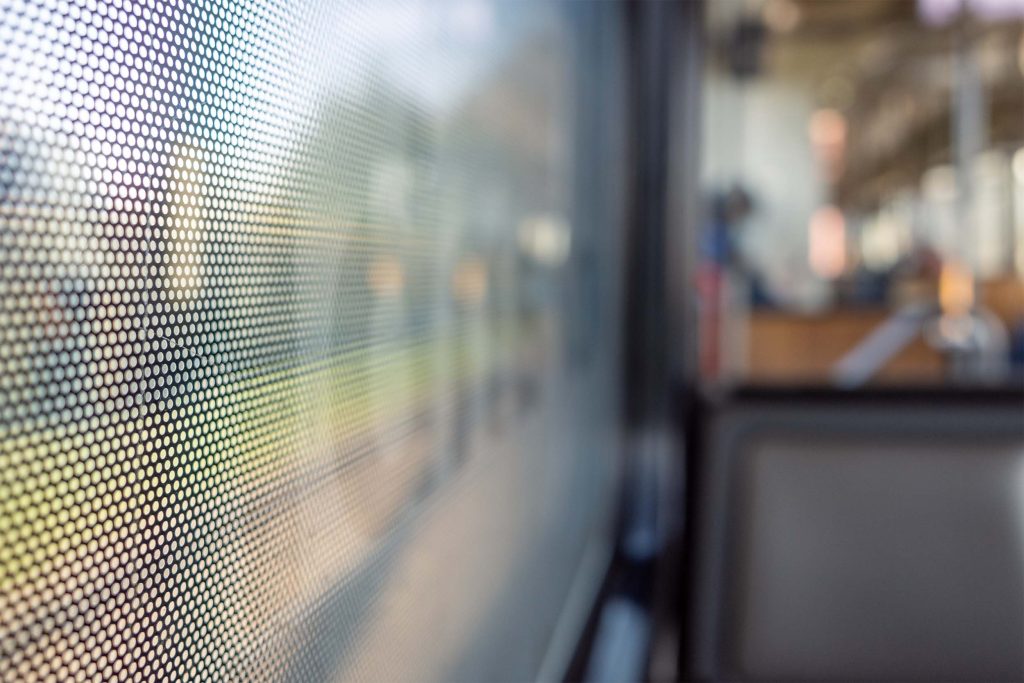
GRAPHTEC
We all know the one way, see though perforation for window advertisement graphics for buildings and automobile windows. We know what the legal requirements are for automobile applications, and can provide a hole size and pattern to suit. Transportation advertising on cars, buses, trucks, boats, aircraft.. the options are limitless.
Because of road regulations, window graphics on buildings can be a lower open area, which can make the graphics double as a sun shade. PerfQuest have the tooling and patterns for your to choose the amount of open area, visibility, and the amount of light you would like to restrict. Window perforation provides you with both privacy and a stunning way for you to transform your store windows into impactful displays.
Perforated window vinyl can have the similar UV reducing features as having tinted windows, but with the bonus of a truly a unique, tailor made and inexpensive way to promote your products and business. The vinyl is punched full of clean, small, perforated holes that are precision placed and evenly spaced. The perforations allow the eye to see through the material, creating one-way vision. Lower your cooling costs, protect your glass, create privacy AND promote your business at the same time.
Many other graphics require micro holes so that the air can be removed from the graphic when it is applied. Especially in applications where a PSA (pressure sensitive adhesive) is involved. PerfQuest’s micro-perforating technologies are perfect for this application.
PerfQuest have wide width perforating capacity, we offer quick turn-around times and flexible options.
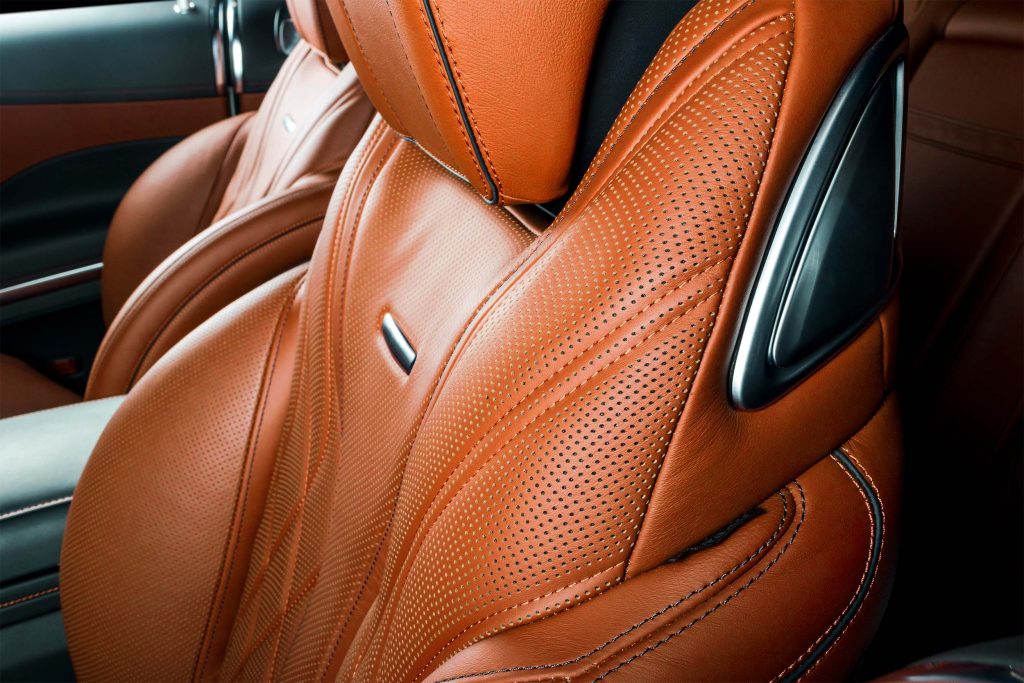
TRANSPORTEC
Perforating in transportation applications are becoming ever more popular for a number of reasons. Perforated automotive seats refer to car seats that feature patterns of small holes or openings in the seat material. This design offers various benefits, including enhanced ventilation, comfort, aesthetics, and moisture management. Perforated seats are commonly used in vehicles to improve driver and passenger experiences, especially in terms of comfort during long drives and in warm weather.
1. They are functional and provide airflow for not only air evacuation when a passenger sits on the seat, but also for heated, ventilated and air conditioned seat technologies. You would much rather be in a perforated seat on a long trip!
2. They are aesthetically pleasing - PerfQuest offer punching technologies that not only provide standard square and staggered hole patterns, but also offer pattern with different size holes, fade away patterns and even logos, perfect for giving a more higher end appearance.
3. Flexibility! A variety of materials can be perforated, leather, artificial leather, vinyl and laminates with foams, plastic films etc.
4. The perforating is not restricted to seats! We have perforated materials for headliners, door panels, steering wheels, sound proofing, the list goes on.
5. Have a higher co-efficient of friction, and the holes make more contact with the object that it is contact with. This in turn makes perforated seating perfect for sports orientated cars, as the driver has more traction with the seat, and more traction on the steering wheel.
6. Acoustical panels have been perforated for years. The perforations allow sound to be funneled through to an absorbent layer. Sound dampening is critical to keeping the inside of the passenger compartment quiet and free from road noise.
7. Bendability! Perforated materials are more flexible than solid materials. Perforations make the leather more supple and comfy to sit in.
8. Unlike traditional noise insulation methods, which might require thicker and bulkier materials, using perforated films with sound-absorbing properties takes up less space, allowing for more efficient cabin design and optimization.

MEDTEC
Perforation technologies are used in medical absorbent pads and bandages for wound care. There are several solutions available, each with its own set of advantages and uses.
1. Poly based film Substrates with Absorbent Padding:
Typically used in absorbent pads and bandage applications. The poly layer serves as a barrier between the wound and the absorbent pad. The absorbent pad can be made from materials like cotton, cellulose, or super absorbent polymers or foams to efficiently soak up bodily fluids from the open wound. Perforations are used to aid and control the flow of fluids from the wound to the absorbent layer.
2. Tapes with Pressure-Sensitive Acrylic or Silicone Adhesives:
Adhesive-backed tapes have layers made from acrylic or silicone that can provide secure attachment to the skin. Perforations can aid in lowering the contact area of the adhesive, making the adhesive less painful when it is removed from the patient.
3. Perforated Barrier-Like Layers:
Perforated substrates allow fluids to move from the wound into the absorbent pad while maintaining a controlled environment that encourages healing of the wound.
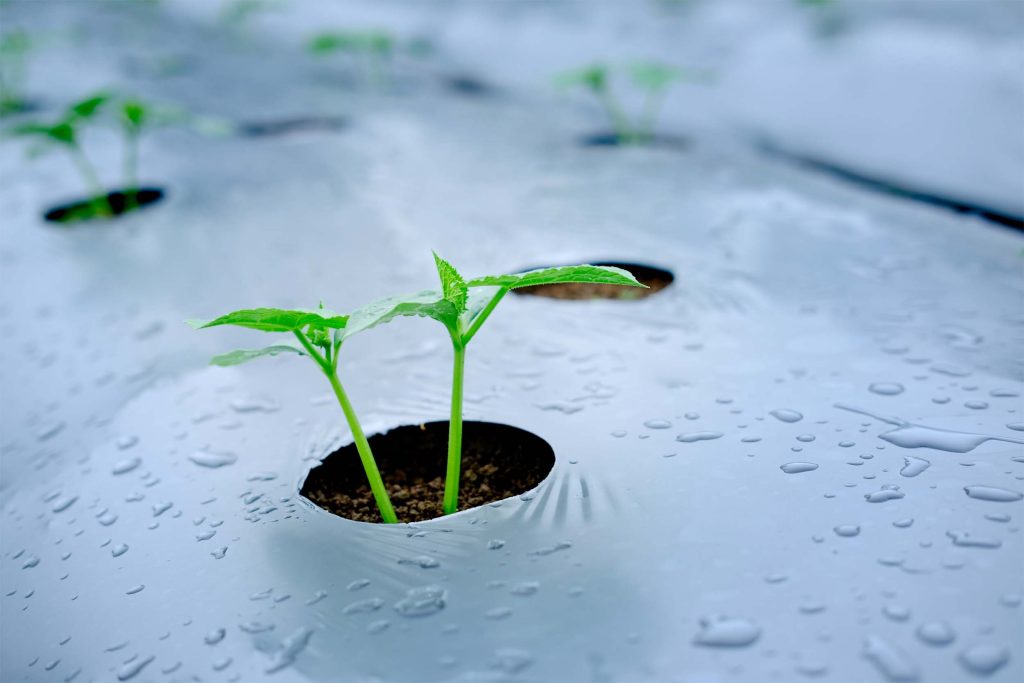
AGROTEC
Perforations often consist of holes or cut-outs in materials. When applied to gardening films and non-wovens, this technology allows for the creation of customized patterns that serve multiple purposes, including weed control, moisture management, and strategic placement for plants.
Weed Control: Perforated films act as a barrier to weed growth while allowing for the passage of moisture. The controlled cut-outs can be designed to fit around plant locations, effectively preventing weeds from taking over while accommodating plant growth.
Moisture Management: Perforations help ensure proper moisture distribution to seedlings and plants. Moisture is allowed to reach the roots without creating waterlogged conditions that can lead to disease.
Plant Layouts: Custom patterns of cut-outs enable growers to strategically place plants in pre-planned layouts. This can improve plant organization, maximize space, and enhance aesthetic appeal.
Reduced Manual Labor: Custom patterns eliminate the need for manual cutting or trimming, saving time and effort during the planting process.
Drainage Control: Perforations are controllable and can limit the amount of drainage in a film, allowing for liquid retention as required.
Customization: Different plant varieties have varying space requirements. The ability to create custom patterns enables tailored solutions for different gardening needs.

AEROTEC
Aerospace films perforation involves the process of creating controlled holes or perforations in films used in the aerospace industry. These films are often utilized for various purposes in aircraft and spacecraft, such as insulation, structural components, thermal protection, and more. The perforation process can have specific applications and benefits in the aerospace sector:
Purposes of Aerospace Films Perforation:
Thermal Management: Perforated films can help regulate heat distribution and dissipation within aerospace components. By creating perforations strategically, heat can be channeled or dissipated more efficiently.
Pressure Equalization: In pressurized environments like aircraft cabins, perforations can be used to allow controlled pressure equalization between the inside and outside of the aircraft, preventing issues caused by rapid pressure changes.
Aerodynamic Efficiency: Perforations can be used to modify the airflow over certain aerospace surfaces, optimizing aerodynamic performance and reducing drag.
Vibration Damping: Perforated films can contribute to vibration damping by altering the mechanical properties of the material. This is important in reducing vibrations that may affect aircraft stability.
Acoustic Control: Perforations can be engineered to control sound transmission, allowing for better acoustic insulation within the aerospace structure.

BUILDTEC
Construction perforated films are specialized materials used in the construction industry that feature controlled perforations or holes. These perforations serve various purposes in building projects, ranging from moisture management to ventilation and aesthetics. Construction perforated films are applied to walls, roofs, floors, and other architectural elements to achieve specific functional and design goals. Here are some common applications and benefits of construction perforated films:
Applications of Construction Perforated Films:
Moisture Management: Perforated films are often used as vapor barriers to manage moisture within building assemblies. The perforations allow for controlled vapor diffusion, preventing condensation and moisture buildup that could lead to mold and structural damage.
Ventilation: Perforated films can be strategically placed to provide passive ventilation in building systems. They allow air circulation while preventing the entry of pests, debris, or excessive moisture.
Acoustic Control: Perforated films can enhance sound absorption and insulation within buildings, contributing to a more comfortable and quiet indoor environment.
Aesthetic Design: Perforated films can be used for decorative purposes, creating visually appealing patterns or textures on walls, ceilings, or other surfaces.
Facade Systems: In modern architecture, perforated films are used in facade systems to regulate daylight and solar heat gain while maintaining aesthetic appeal.
Benefits of Construction Perforated Films:
Moisture Protection: Perforated films with vapor barrier properties help prevent moisture-related issues such as mold growth and material degradation.
Energy Efficiency: Properly designed perforated films can contribute to energy efficiency by allowing controlled airflow and ventilation, reducing the need for mechanical ventilation systems.
Improved Indoor Environment: Perforated films used for acoustic control help create quieter and more comfortable indoor spaces.
Durability: Many construction perforated films are engineered to withstand various weather conditions, UV radiation, and other environmental factors.
Aesthetic Enhancement: Perforated films used for aesthetic purposes can add texture, depth, and visual interest to building surfaces.
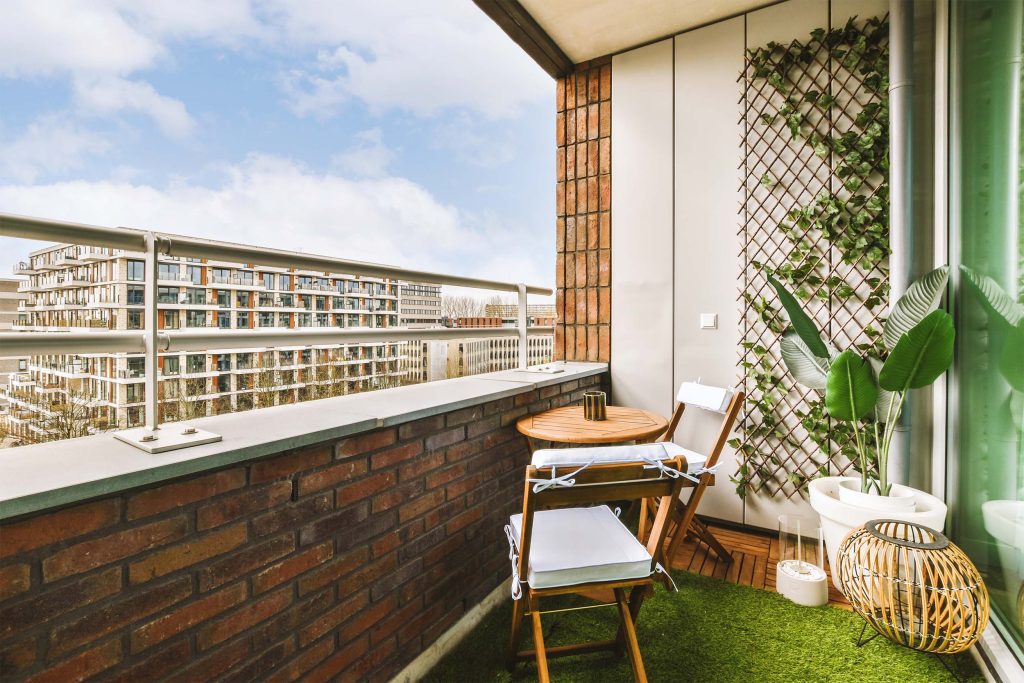
HOMETEC
Perforated Films for House Wrap:
House wrap films are using perforating methods. These perforated films are installed on the exterior of buildings to provide a protective barrier against moisture infiltration while allowing the passage of moisture vapor. By controlling the size, shape, and density of the holes, it’s possible to create a material that permits vapor transmission while hindering the entry of liquid water.
Perforated Movie Screens:
A perforated movie screen is a specialized type of projection screen that features a pattern of small holes or perforations on its surface. This design is primarily used in cinema environments where audio systems are placed behind the screen, allowing sound to pass through the perforations while maintaining high-quality visual projection. The use of perforated screens enhances the audiovisual experience by ensuring that the sound aligns seamlessly with the on-screen action.
Astroturf:
Perforated astroturf, also known as perforated artificial turf or perforated synthetic grass, refers to artificial grass surfaces that are designed with small holes or perforations to allow for improved drainage and water management. This type of astroturf is commonly used in outdoor areas where rainwater or other liquids need to flow through the turf to prevent water accumulation and maintain a dry and safe surface. Perforated astroturf finds applications in various sports fields, playgrounds, landscaping, and other outdoor environments.
Sun shades:
A perforated sun shade, also known as a perforated sun screen or sun shading system, refers to a type of architectural element designed to provide shade, reduce glare, and control sunlight while allowing some degree of visibility and airflow. These shades are typically made from materials with carefully designed patterns of openings or holes, offering a balance between protection from the sun’s rays and maintaining a connection with the surroundings.
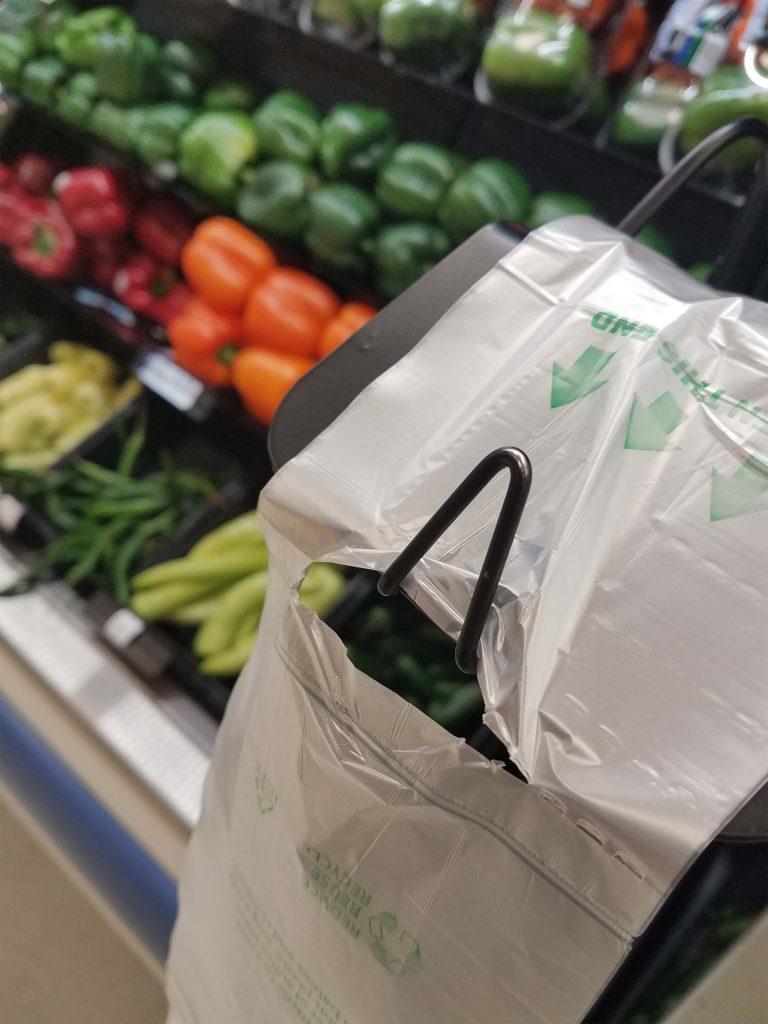
PACTEC
Fresh cut veggies and fruit
Different varieties of fresh-cut produce have specific requirements for headspace within their packaging to extend shelf life effectively. The headspace, which refers to the air-filled area within the packaging, plays a crucial role in maintaining the desired atmosphere and moisture levels around the produce. This can significantly impact freshness and shelf life.
In the context of packaging, "barrier qualities" refer to the ability of the packaging material to control the exchange of gases (such as oxygen and carbon dioxide) and moisture between the packaged environment and the external atmosphere. Packaging materials with high barrier properties are designed to prevent the ingress of oxygen and moisture and the egress of carbon dioxide, thus creating a controlled atmosphere that can help extend the shelf life of perishable products. However, the inherent barrier qualities of commonly used lidding and bag films might not allow for the optimal headspace required by specific types of fresh-cut produce. This can lead to challenges in maintaining the desired atmosphere and moisture levels within the package, potentially resulting in accelerated deterioration and reduced shelf life. This is where microperforated films come in. Microperforated films have tiny holes that allow for controlled gas exchange between the inside and outside of the package. These films can be customized to provide the necessary headspace while still maintaining a certain level of barrier properties. This approach is particularly useful for produce that requires a specific balance of gases.
Ultimately, the choice of packaging material and strategy depends on the type of produce, the desired shelf life extension, and the specific environmental conditions that need to be maintained. Collaboration between produce suppliers, packaging manufacturers, and food scientists is crucial to finding the most suitable packaging solution for each variety of fresh-cut produce. PerfQuest is here to assist with this endeavor.
Using perforation for frozen-food packaging is indeed a smart solution to address the need for steam venting while maintaining the integrity of the packaging during freezing and distribution. Micro perforation technologies offer precise control over hole size, pattern, and distribution, making it an ideal choice for creating steam-release points.
Foam Trays for meat and fish:
Fluid Management: The one-way valve created by perforations enables excess fluids to be absorbed by the tray-liner pad, which helps keep the protein product dry and visually appealing.
Freshness: By maintaining the right internal atmosphere through controlled gas exchange, the product’s freshness can be extended, reducing spoilage and waste.
Perforation Size and Density: Careful attention should be given to determining the optimal perforation size and density to ensure the desired one-way valve effect. Too many or too large perforations could compromise the product’s quality and shelf life.
Packaging Material: The choice of packaging material is important. The film used should be compatible with hot-needle perforation and maintain its integrity during distribution and storage.
Using perforations to create a simple one-way valve for foam trays with absorbent tray-liner pads is a clever and effective approach to maintaining the freshness and appeal of protein products like chicken, beef, pork, and more. This method helps manage excess fluids while still keeping the product attractive to consumers. Here’s a breakdown of how the process works and its benefits:
These perforations allow gases (such as oxygen and carbon dioxide) and moisture to move in and out of the package, helping to manage the internal atmosphere and moisture levels. Perforations create a one-way valve effect, allowing fluids to be absorbed by the tray-liner pad while preventing them from escaping.
Lidding for Thermoformed Packaging
Micro perforation is indeed a valuable solution for addressing the challenges of distributing moisture-sensitive cereals in rigid trays, especially in situations involving changes in altitude. The pressure differentials experienced during transportation at higher altitudes can lead to issues such as bursting seals and compromised product quality. Perforations are the solution.

TEXTEC
Technical textiles perforation involves the process of creating controlled holes, openings, or patterns in specialized textiles designed for specific technical or industrial applications. These textiles are engineered to provide functional properties beyond traditional fabrics, such as durability, strength, resistance to environmental factors, and unique performance characteristics. Perforating technical textiles enhances their functionality and allows for customization to meet specific requirements. Here's how perforation is used in technical textiles:
Applications of Technical Textiles Perforation:
Filtration: Perforated technical textiles are commonly used in filtration applications, where controlled openings or holes allow for the passage of fluids or gases while retaining particles or contaminants.
Ventilation and Breathability: Perforations can enhance the breathability of technical textiles used in garments, sportswear, and footwear, allowing moisture vapor and air to escape while maintaining water resistance.
Sound Absorption and Insulation: Technical textiles with perforations can provide acoustic properties by allowing sound waves to enter and be absorbed, contributing to noise reduction and insulation.
Medical and Healthcare: Perforated technical textiles can be used in medical applications such as wound dressings, surgical drapes, and implants, where controlled permeability and moisture management are essential.
Automotive Interiors: Perforated technical textiles are used in automotive interiors to create breathable and comfortable seating materials, as well as for interior panels with integrated ventilation.

COMPTEC
Perforated composites refer to composite materials that feature a pattern of openings, holes, or perforations strategically incorporated into their structure. These perforations can serve various purposes, including weight reduction, enhanced performance, improved functionality, and aesthetic design. Perforated composites are used in a wide range of industries where the combination of different materials creates structures with specific properties and capabilities. Benefits of Perforated Composites:
Weight Reduction: Perforations help reduce the overall weight of composite structures, making them suitable for applications where weight is a critical factor.
Enhanced Performance: Perforated composites can offer improved strength-to-weight ratios, impact resistance, and stiffness compared to solid materials.
Aesthetic Appeal: The design and arrangement of perforations can add a unique visual aesthetic to the composite structure.
Functionality: Perforations can be strategically placed to allow airflow, ventilation, or fluid passage, making them versatile for various applications.
Customization: Perforated composites can be tailored to meet specific design, performance, and functional requirements.
Using perforated films as a sacrificial envelope for bonding composite plastic materials is a forward-thinking approach to lightweighting in various industries such as aviation, automotive, marine, and recreational vehicles. This method not only helps in creating strong composite structures but also addresses challenges related to gas venting during the curing process. Perforations assist in achieving strong bonding between these layers while also preventing the buildup of excess gas during the curing process.

